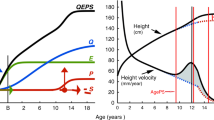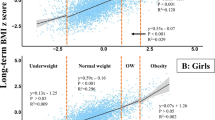Abstract
Objective: To evaluate the dependence of body mass index (BMI) values on pubertal stage in subjects similar in age.
Design, subjects and measurements: Height and weight were recorded cross-sectionally in school subjects from three provinces in central Italy. The subjects were subdivided into three groups: (1) 4271 school subjects (2125 males and 2146 females; 8.5–15.5 y old), in whom the pubertal development was also recorded, were selected to subdivide BMI values according to pubertal stage and age; (2) 6345 females (10.5–14.5 y old), who were asked whether or not they had had their first menstrual period, were selected to subdivide BMI values according to age in pre-menarche and post-menarche girls, separately; and (3) 1919 females (10.5–14.5 y old), who had presented their menarche within the previous 6 months, were selected to subdivide short-term post-menarche BMI values according to age.
Results: The medians and interquartile ranges of BMI varied according to age and pubertal stage. Kruskall–Wallis test performed in subjects similar in age demonstrated that significant differences existed among the medians of BMI values of subjects at different pubertal stages in 12–14-y-old males (P<0.05), and in 11–14-y- old females (P<0.001). The difference also proved to be significant between stage I and stage II (P<0.05) in 10-y-old females, but not in 10–11-y-old males. The Kruskal–Wallis test performed in subjects similar in pubertal stage demonstrated that significant differences among the medians of BMI at different ages existed only in females at stages II and III. A significant positive trend was observed in both genders according to pubertal stage for BMI values of subjects similar in age (z-test for trend, P<0.01). On the contrary, a negative age trend proved to be significant in females at stages I (P<0.01), II (P<0.01) and III (P<0.001), but not in males when the subdivision of BMI was made according to age in subjects similar in pubertal stage. BMI values were significantly higher in post-menarche girls as compared to pre-menarche girls similar in age (P<0.001). However, at partial regression analysis BMI values were influenced by pubertal stage and, to a lesser extent, by age, but not by menarcheal status. An inverse association between short-term post-menarche BMI and age was observed, with the highest values in girls presenting menarche at 11 y of age (P<0.05). The negative trend was demonstrated at the z-test for trend (P<0.001).
Conclusions: BMI values depend on pubertal degree of maturation, especially in girls. This influence should be taken into account when BMI is evaluated in adolescents.
Sponsor: University of Perugia, Region of Umbria.
Eyropean Journal of Clinical Nutrition (2000) 54, 214–218
This is a preview of subscription content, access via your institution
Access options
Subscribe to this journal
Receive 12 print issues and online access
$259.00 per year
only $21.58 per issue
Buy this article
- Purchase on Springer Link
- Instant access to full article PDF
Prices may be subject to local taxes which are calculated during checkout
Similar content being viewed by others
Author information
Authors and Affiliations
Contributions
Guarantor: A Falorni
Contributors: VB was mainly responsible for the original idea, and he provided the final data collection, executed the mathematical and statistical analysis and participated in designing the study and in the writing of the paper. FC, MGB, MLB, PS, PG and LT organized and co-ordinated the research project on the growth of school children in the three provinces of Perugia, Terni and Rieti, participated in the collection of data on growth and pubertal maturation from the school population survey, and executed and provided protocol adherence; all of them contributed to interpreting the data and the writing of the paper. AF participated in developing the original idea, designing the study, analysing the data and writing the paper. He also directed protocol execution and adherence.
Corresponding author
Rights and permissions
About this article
Cite this article
Bini, V., Celi, F., Berioli, M. et al. Body mass index in children and adolescents according to age and pubertal stage. Eur J Clin Nutr 54, 214–218 (2000). https://doi.org/10.1038/sj.ejcn.1600922
Received:
Revised:
Accepted:
Published:
Issue Date:
DOI: https://doi.org/10.1038/sj.ejcn.1600922
Keywords
This article is cited by
-
Dental biorhythm is associated with adolescent weight gain
Communications Medicine (2022)
-
The effect of heavy prenatal alcohol exposure on adolescent body mass index and waist-to-height ratio at 12–13 years
International Journal of Obesity (2021)
-
Parental Employment, Shared Parent–Child Activities and Childhood Obesity
Journal of Family and Economic Issues (2011)
-
Different Mechanisms Underlie Post-menarchial Increase in Depression and Weight
International Journal of Behavioral Medicine (2011)
-
Changes and Tracking of Fat Mass in Pubertal Girls
Obesity (2010)



